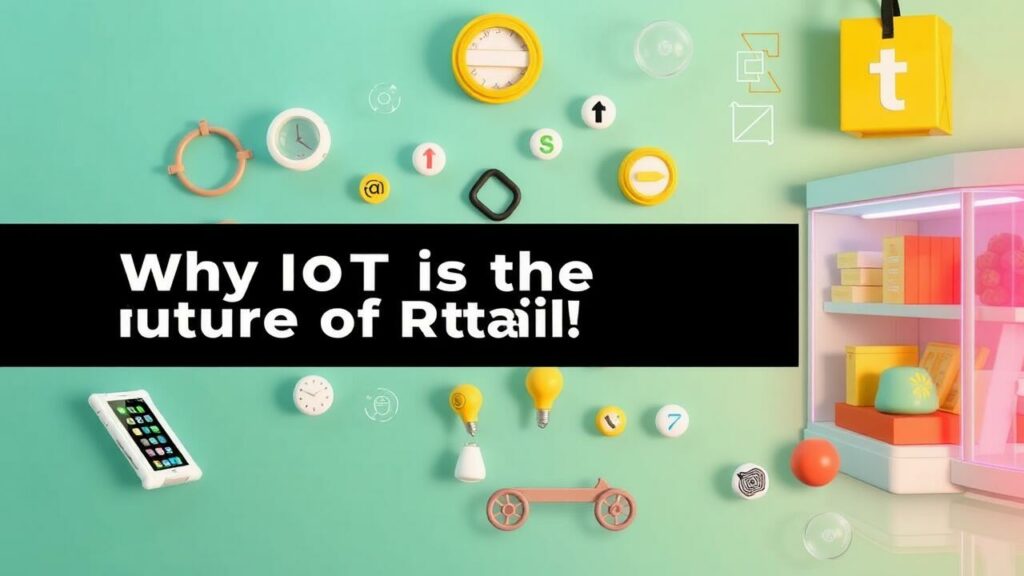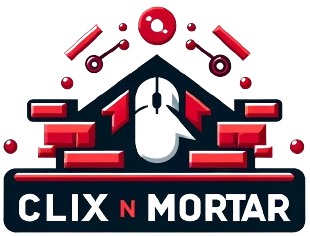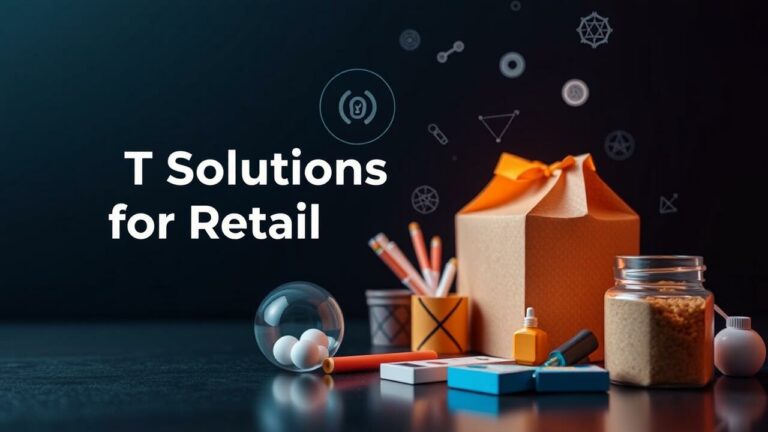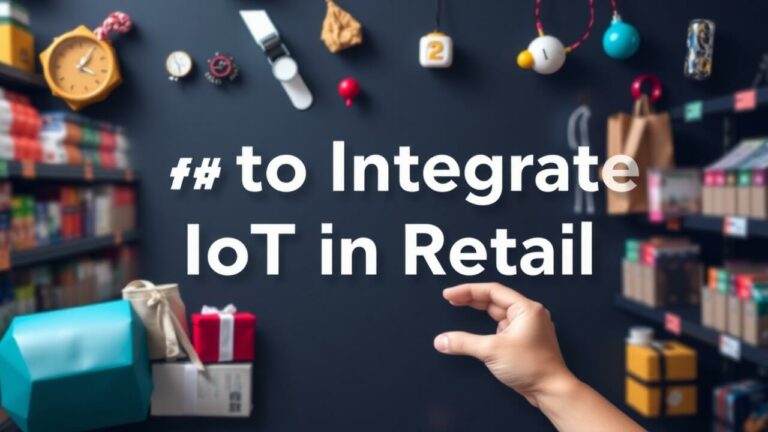Why IoT is the Future of Retail
Table Of Contents
Discover Why IoT is the Future of Retail and Transform Your Business Strategy
Key Takeaways
- The significance of IoT in the retail domain and its potential impact.
- Advantages provided by IoT for retail enterprises.
- Practical uses of IoT technology within the retail sector.
- Obstacles faced when adopting IoT solutions in retail.
- Upcoming developments anticipated in the IoT retail landscape.
- Examples of effective IoT implementation in various retail scenarios.
Why IoT Is The Future Of Retail | Understanding IoT in the Retail Sector
The retail industry is undergoing a transformative shift driven by the Internet of Things (IoT) technology. Understanding why IoT is the future of retail requires exploring the diverse applications of IoT devices in retail spaces, which significantly enhance customer experiences, streamline operations, and boost efficiency. Retail companies are increasingly adopting the industrial internet of things to manage inventory in real-time, personalize shopping experiences, and optimize supply chains. This integration of IoT in retailing not only creates a more dynamic retail market but also positions businesses to respond swiftly to consumer needs. As the retail landscape continues to evolve, it becomes clear that IoT’s role is pivotal in shaping the future of retail.

Why IoT is the Future of Retail | Definition and Overview of IoT
IoT, or the Internet of Things, is revolutionizing retail businesses by connecting various devices and systems to enhance operational efficiency. This technology allows retail stores to gather real-time data from interconnected devices such as point-of-sale (POS) systems, inventory management tools, and customer engagement platforms. By leveraging these technologies, retailers can gain valuable insights into customer preferences and streamline their operations, leading to improved profitability and customer satisfaction. Understanding why IoT is the future of retail is essential for businesses looking to gain a competitive edge in today’s fast-evolving market.
The integration of the internet of things into retail shops offers a range of transformative benefits. Retailers can utilize IoT to optimize inventory management, track customer behavior, and personalize shopping experiences. This technology enables real-time monitoring and analysis, allowing businesses to swiftly adapt to changing market demands. As the retail landscape continues to evolve, understanding why IoT is the future of retail becomes crucial for retailers aiming to embrace innovation and enhance overall performance.
How IoT Technology Works in Retail
IoT technology revolutionizes retail by connecting various smart devices to the internet, enabling real-time data exchange. This innovation is evident in smart point-of-sale (POS) systems that streamline transactions and enhance the shopping experience. Vending machines equipped with IoT sensors can monitor inventory levels while ensuring that merchandise is always stocked. With location-based services, retailers can deliver personalized marketing messages to shoppers, driving engagement and increasing sales. Understanding why IoT is the future of retail lies in its ability to transform everyday shopping into a seamless, efficient process.
The integration of IoT extends beyond the shop floor to warehouses, where smart devices track inventory and optimize storage solutions. Retailers are leveraging this technology to enhance supply chain management by examining data across various touchpoints. As smart devices collect and analyze information, businesses can anticipate customer demand and refine their strategies accordingly. The potential for innovation within the retail sector shows why IoT is the future of retail, providing powerful insights that allow companies to stay ahead in a competitive market.
Benefits of IoT for Retail Businesses
The integration of IoT technology in retail businesses is transforming how brick-and-mortar stores operate and engage with consumers. By leveraging internet connectivity, retailers can optimize their supply chains, ensuring that products are available when and where they are needed. Smart shopping carts equipped with IoT sensors allow for real-time tracking of items and automated updates to point of sales systems, streamlining the checkout process. Retailers can implement targeted marketing strategies using data collected from consumer interactions, making promotions more relevant and effective. This evolution contributes to a dynamic market landscape where discount stores compete with traditional establishments, explaining why IoT is the future of retail. Through enhanced inventory management and personalized experiences, businesses can reduce prices while increasing customer satisfaction.
Enhancing Customer Experience through IoT
The integration of IoT technologies in retail is set to redefine customer engagement and satisfaction. Drug stores, for example, are leveraging retail IoT applications to create a seamless shopping experience. Smart shelves equipped with IoT technology can track inventory levels in real time, ensuring that customers find their desired products readily available. This proactive approach enhances supply availability and minimizes frustration, showcasing why IoT is the future of retail. By utilizing today’s IoT technologies, retailers can personalize their offerings, tailoring promotions and recommendations based on individual customer preferences.
IoT can play a crucial role in reshaping not just backend retail operations but also customer journeys. Retailers are adopting IoT technology systems that provide insights into consumer behavior and preferences through connected devices. This data empowers businesses to optimize store layouts and product placements, further enhancing customer satisfaction. As IoT is revolutionizing the retail industry, it enables a connected infrastructure that enhances the overall shopping experience. Embracing such innovations clarifies why IoT is the future of retail, positioning businesses for growth in an increasingly digital landscape.
| IoT Application | Benefit | Example |
|---|---|---|
| Smart Shelves | Real-time inventory tracking | Automated restocking alerts in drug stores |
| Personalization Engines | Tailored promotions and recommendations | Customized offerings based on shopping history |
| Connected Devices | Insights into consumer behavior | Data-driven store layout optimization |
| Mobile Apps | Enhanced customer engagement | Push notifications for in-store deals |
Optimizing Supply Chain Management
Effective supply chain management transforms retail operations through the integration of IoT systems. These systems enable real-time monitoring of inventory levels, streamlining logistics, and enhancing operational efficiency. By implementing an IoT strategy, retailers can leverage various IoT platforms to automate processes, reducing waste and improving responsiveness to demand fluctuations. Global IoT spending continues to rise, showcasing the industry’s commitment to smart retailing.
IoT applications within supply chains facilitate better collaboration among stakeholders. IoT devices will help consumers find the right products by providing accurate data on stock availability and location. Tracking with IoT machines ensures timely deliveries, while advanced IoT software analyzes trends to optimize inventory. Such innovations contribute to enhanced decision-making and operational agility, emphasizing why IoT is the future of retail.
RealWorld Applications of IoT in Retail
The rapid evolution of smart retail demonstrates why IoT is the future of retail. Businesses are embracing IoT adoption to enhance operational efficiency and customer satisfaction. Smart stores utilize IoT-enabled devices such as sensors and cameras to gather real-time IoT data, enabling informed decision-making and inventory management. This network of connected retail devices not only improves customer experiences but also frees employees from mundane tasks, allowing them to focus on engagement. Leveraging experienced IoT software for retail innovation, companies can implement tailored IoT solutions that streamline processes and foster a more responsive shopping environment. The integration of these technologies signals a significant shift towards a more dynamic and responsive industry landscape, underscoring why IoT is the future of retail.
| Application | Description | Benefits |
|---|---|---|
| Smart Shelves | IoT-enabled shelves that monitor inventory levels in real-time. | Reduces out-of-stock scenarios and improves inventory accuracy. |
| Customer Tracking | Using sensors to track customer movements and behavior in stores. | Enhances store layout optimization and marketing strategies. |
| Predictive Analytics | Analyzing data from IoT devices to predict trends and customer preferences. | Enables personalized promotions and better stock management. |
| Smart Carts | Carts equipped with IoT technology that interact with customer smartphones. | Facilitates a seamless shopping experience and faster checkouts. |
Smart Shelves and Inventory Management
The integration of IoT technology into inventory management transforms the retail environment. Retail automation technology utilizes IoT-powered POS systems and IoT-based sensors to provide real-time visibility into stock levels. Retailers can effectively track inventory through IoT tools, reducing human errors and optimizing stock replenishment. With smart store environments, businesses can maintain an organized inventory management system, leading to enhanced operational efficiency. This shift to intelligent retailing illustrates why IoT is the future of retail, enabling companies to respond swiftly to consumer demand.
IoT sensors play a crucial role in streamlining inventory management processes. These retail sensors monitor product availability and shelf conditions in real-time, ensuring that customers find what they need. As IoT platform integration becomes more sophisticated, retailers can gather valuable data about consumer behavior and preferences. This information enables better decision-making regarding product placement and promotions. The IoT gain in this sector not only boosts sales but also strengthens customer loyalty, further emphasizing why IoT is the future of retail.
Personalized Marketing Strategies
The integration of IoT data analytics into marketing strategies allows forward-thinking retailers to understand customer behavior on a deeper level. By utilizing a comprehensive IoT ecosystem, brands can collect and analyze data from retail sensors placed throughout the store, which contributes to personalizing the shopping experience. This tailored approach enables retailers to offer targeted promotions and enhance customer engagement, showcasing why IoT is the future of retail.
Retail looks to leverage IoT solution programs that analyze customer preferences and shopping patterns. Many retailers are adopting a retail sensor platform to gather real-time insights on foot traffic and product interactions. Such strategies optimize marketing efforts and ensure that promotions resonate more effectively with consumers. The evolution of personalized marketing not only enhances the retail experience but also reinforces how IoT continues to reshape the industry landscape.
Challenges in Implementing IoT in Retail
Implementing IoT in the retail sector presents a variety of challenges that forward-looking retailers must address to fully leverage the potential of this transformative technology. As retailers explore how IoT is the future of retail, they often encounter obstacles such as data security and privacy concerns that can impact consumer trust and loyalty. The integration of things technology into existing retail operations requires significant investment and strategic planning, especially for stores and warehouses looking to optimize their processes. The retail industry experience can be enhanced through seamless communication between autonomous stores and in-store consumers, but achieving this demands comprehensive retail solutions that address the unique needs of diverse retail operations. Failure to navigate these challenges may lead to wasted resources, preventing retailers from realizing the billions in potential benefits.
Data Security and Privacy Concerns
The integration of IoT technology presents distinct challenges related to data security and privacy. As physical stores adopt smart technology, they collect vast amounts of customer data through various retail solutions. Protecting this sensitive information is crucial for maintaining trust between retailers and shoppers. If not managed properly, breaches could significantly affect retail store traffic and customer loyalty. Retail employees must be trained on best practices to safeguard data, ensuring that in-store systems remain secure.
Another concern involves the potential misuse of collected data. Retail management solutions often analyze customer behavior to optimize inventory and enhance the shopping experience. However, if these insights are not handled responsibly, they could lead to privacy violations. Successful store strategies should include transparent data usage policies to inform customers about how their information is utilized. As the industry navigates these complexities, addressing data security and privacy effectively will play a pivotal role in Why IoT is the Future of Retail.
Integration with Existing Systems
Integrating IoT technology with existing systems poses significant challenges for retailers. Many shops currently rely on traditional inventory management and retail marketing solutions, making it difficult to incorporate store shelf sensors and IoT-based surveillance systems seamlessly. Retailers place products based on historical data, and adapting to the real-time insights provided by modern technology requires substantial shifts in operational processes. The need for compatible in-store equipment becomes essential for harnessing the full potential of IoT, particularly amidst an ever-evolving store environment.
Tech-savvy consumers increasingly expect personalized shopping experiences, pushing retailers to adopt new technologies. Understanding Why IoT is the Future of Retail means recognizing the necessity for systems that can interact with existing infrastructures. The transition to connected devices, such as store shelf sensors, demands that retailers find effective ways to blend traditional practices with innovative solutions. An inability to integrate these systems may hinder retailers from crafting tailored retail offers that resonate with the expectations of many consumers, ultimately impacting sales and customer satisfaction.
- Retailers need to assess their current inventory management systems for compatibility with IoT technology.
- Investment in training staff on new integrated processes is crucial for successful implementation.
- Ongoing maintenance and updates of IoT systems must be considered to ensure seamless operation.
- Collaboration with technology vendors can facilitate smoother integration of IoT devices.
- Thorough testing and gradual rollout of new systems can minimize disruption during the transition.
- Data security measures must be prioritized when connecting IoT devices to existing systems.
- Feedback from customers should be collected to refine and enhance the integrated shopping experience.
Future Trends of IoT in the Retail Industry
The retail industry is on the cusp of a transformation driven by cutting-edge IoT technology. As businesses recognize Why IoT is the Future of Retail, the integration of smart shelves will enable real-time inventory management, enhancing operational efficiency. This technological upgrade not only streamlines retail functions but also enriches the time customers spend in physical stores. With the worldwide market for IoT in retail projected to grow significantly, retailers are increasingly focusing on digital worlds that complement traditional stores. Popular store sections will see advancements that tailor the shopping experience, seamlessly blending the physical and digital realms to meet evolving consumer expectations.
- Improved customer personalization through data analytics and targeted marketing.
- Enhanced supply chain visibility to prevent stockouts and overstock situations.
- Smart payment systems to facilitate faster and more secure transactions.
- Integration of Augmented Reality (AR) to enhance the shopping experience.
- Use of beacons for location-based promotions and customer engagement.
- Increased focus on sustainability through smart energy management and waste reduction.
- Development of smart fitting rooms for a more interactive and convenient shopping experience.
The Role of Artificial Intelligence and Machine Learning
Artificial Intelligence (AI) and Machine Learning (ML) are pivotal in shaping a responsive shopping environment, making them essential for understanding why IoT is the future of retail. These technologies enhance in-store operations by analyzing customer interactions and preferences in real time. Brick-and-mortar retailers can leverage AI to optimize in-store merchandising, leading to a smarter shopping experience. By integrating IoT-enabled RFID tags, retailers can achieve smarter inventory management, ensuring that store shelves are always stocked according to market changes and customer demand.
The promising future of retail lies in the seamless synergy between IoT, AI, and ML. AI-driven analytics can transform real-time inventory data into actionable insights, allowing retailers to refine store operations efficiently. As retailers adopt these technologies, they will be better positioned to adapt to evolving consumer behaviors, ultimately reinforcing why IoT is the future of retail. This integration not only streamlines processes but also enhances customer satisfaction, paving the way for innovative retail experiences.
Emerging Technologies Complementing IoT
The integration of IoT with emerging technologies significantly enhances the retail landscape. Smart delivery services and inventory-managing devices streamline merchandise movement and enable efficient supply chain tracking. Retailers can utilize these innovations to ensure that in-store staff are equipped with real-time data. This leads to a more convenient shopping experience as consumers can easily find the products they intend to purchase. Why IoT is the Future of Retail becomes evident as these technologies transform how businesses operate and meet customer demands.
Emerging technologies such as artificial intelligence and data analytics also play a crucial role in complementing IoT solutions within the retail grocery market. By leveraging these technologies, retailers can create personalized offers based on consumer purchase patterns. Digital-driven experiences enhance shopper engagement while optimizing overall inventory management. Understanding why IoT is the future of retail hinges on recognizing the importance of these complementary technologies in creating a seamless and efficient shopping experience.
Case Studies of Successful IoT Integration
Successful integration of IoT in retail showcases transformative changes that align with why IoT is the future of retail. For instance, smart shelves equipped with sensors provide real-time data on product availability, significantly reducing common shopping hassles. This not only enhances store layout by ensuring popular shopping paths are stocked but also improves supply chain efficiency, allowing retailers to respond dynamically to purchasing decisions. Retailers can create clean and organized retail spaces while leveraging digital experiences that resonate with buyers. These case studies illustrate how the industry can harness IoT platforms to elevate customer engagement and streamline operations.

Conclusion
The significance of understanding why IoT is the future of retail lies in its ability to transform how businesses operate in the digital age. Retailers must adapt to evolving shopper preferences, utilizing IoT to optimize store layouts and enhance the overall shopping experience. Store managers can leverage IoT technology to analyze customer movement and tailor their selling strategies accordingly, ensuring alignment with market demands. As IoT continues to evolve, embracing these innovations will be critical for their future success, ultimately redefining the retail landscape.
FAQS
How does IoT technology today impact retail space management and contribute to smart inventory management?
Today, IoT technologies significantly enhance the retail experience by providing an internet connection that facilitates a smart inventory management system. This technology frees employees to focus on customer service while making retail store shelves more organized. The distinct IoT use in stores and warehouses allows retailers to track products more efficiently, leading to substantial cost savings and improved market size. The continued development of IoT software brings billions to retailers as they adopt these innovative solutions to keep their retail space clean and operationally efficient.
In what ways do today IoT technologies enhance supply chain management and support retailers in optimizing their operations in stores and warehouses?
Today IoT technologies significantly enhance supply chain management by providing retailers with real-time data, allowing them to make informed decisions that improve efficiency and operations in both stores and warehouses. IoT brings internet connectivity to every aspect of the retail process, ensuring that all parts of the supply chain are interconnected. Additionally, IoT development helps create software solutions that streamline inventory management and frees employees from mundane tasks, ultimately contributing to significant savings for retailers. With the rise of smart networks, retailers can leverage IoT to analyze performance and optimize their processes, driving billions in savings for the retail industry.
How can retailers leverage IoT technology today to improve store operations and enhance inventory management?
IoT technology today significantly enhances store operations by providing retailers billions in savings through improved inventory management and optimized supply chains. By integrating IoT software development and utilizing an effective IoT network, retailers can streamline processes that free employees from mundane tasks. Moreover, IoT enhances supply visibility, allowing stores and warehouses to utilize resources more efficiently. These ways retailers adapt to the evolving landscape ensure that they remain competitive in the multifaceted retail environment.
How does IoT technology free up employees in retail stores and contribute to the overall efficiency of operations in stores and warehouses?
IoT technology frees employees by automating repetitive tasks, allowing them to focus on customer service and strategic initiatives. As IoT enhances the management of products and data in retail, it contributes to a more streamlined workflow, leading to increased efficiency. This shift allows retail to adapt quickly, ensuring that stores and warehouses operate effectively, making it easier for retailers to serve customers seamlessly.
How can the implementation of IoT solutions lead to better operation efficiencies and contribute to how retail comes to free up employee workloads in stores and warehouses?
The implementation of IoT solutions significantly enhances retail operations by automating various tasks, which in turn frees employees for more critical activities. In this way, IoT contributes to a more efficient use of resources, allowing retailers to focus on improving customer service and optimizing workflows in stores and warehouses.
How does the integration of IoT technology lead to improved efficiency in retail operations, specifically how it frees employees in stores and contributes to the overall productivity of retail in relation to stores and warehouses?
The integration of IoT technology in retail significantly frees employees by automating routine tasks and providing real-time data, which enhances decision-making. This innovation not only improves operational efficiency but also allows retail to come up with better strategies for managing stores and warehouses. Ultimately, IoT contributes to a more streamlined workflow, enabling employees to focus on higher-level tasks and improving the overall effectiveness of retail operations in stores and warehouses.
How do IoT solutions in retail come to play a significant role in how it frees employees and contributes to better efficiency in stores and warehouses?
The integration of IoT solutions in retail not only enhances operational efficiency but also effectively frees employees from mundane tasks, allowing them to focus on more value-added activities. By automating inventory tracking and monitoring customer behaviors, retail comes to leverage these technologies to streamline operations in stores and warehouses, ultimately leading to improved productivity and better service.
How can the adoption of IoT technology in retail contribute to freeing employees in stores and enhancing efficiency in warehouses?
The adoption of IoT technology in retail significantly contributes to how it frees employees and enhances efficiency in stores and warehouses. By automating routine tasks and providing real-time data, IoT solutions enable staff to focus on more value-added activities, improving overall productivity and streamlining operations across retail stores and warehouses.
How do IoT applications in retail play a role in enhancing productivity and freeing employees in stores and warehouses?
The integration of IoT in retail contributes significantly to how retail operations work, as it frees employees through automation and efficient management systems. By adopting IoT solutions, stores and warehouses can optimize processes, allowing staff to focus on higher-value tasks rather than mundane operations, ultimately enhancing overall efficiency and productivity in the retail environment.
How can retailers utilize IoT technology to improve the roles of their employees in stores?
The adoption of IoT technology in retail plays a crucial role in how it frees employees by automating routine tasks, thus allowing them to focus on more critical activities within the stores and warehouses. By leveraging IoT solutions, retailers can enhance efficiency in stores, leading to better overall productivity as employees are freed from monotonous duties.






